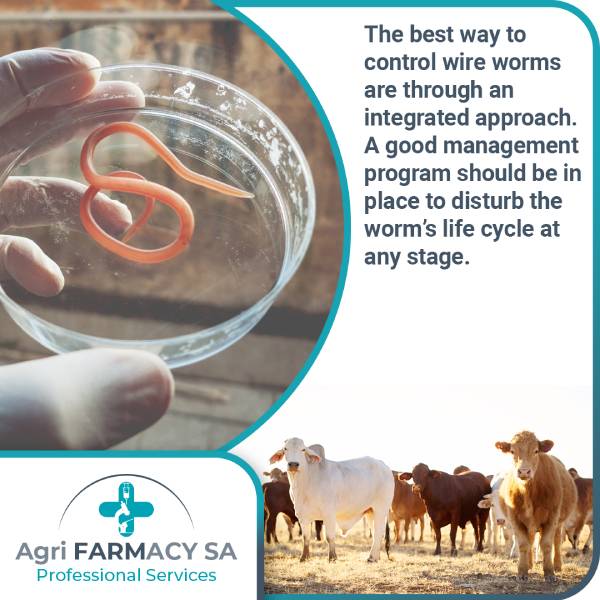Haemonchus contortus is a gastrointestinal parasitic roundworm, commonly referred to as barber’s pole worm, twisted stomach worm, and wire worm2,4. Even though there are a lot of gastrointestinal roundworms, H. contortus is the most economically important parasite in sheep and goats, because they cause haemonchosis worldwide8.
Lifecycle/ Distribution/ Transmission
H. contortus life cycle is direct, just like most parasitic roundworms3,10. This means that there are no secondary hosts’ involved10. The life cycle of the wire worm takes more or less 3 weeks to complete3,10,12. Female wire worms lay thousands of eggs per day9. These eggs are excreted through the sheep/goats faeces3,10. Eggs give rise to free-living larval stages (L1-L3) by incubating in the faeces of the host5. Infective larvae are ingested when sheep graze on the pasture12. Once the larvae enter the sheep’s stomach, they make their way to the abomasum (fourth stomach) where they continue to grow into egg producing adults12.
Pathology/ Clinical signs and symptoms/ Diagnosis
Small ruminants can experience super acute, acute, or chronic haemonchosis11. In the super acute form, it is not uncommon for deaths to occur within the period of one week without obvious signs and symptoms, but this seldom happens, only in immune compromised lambs and sheep11. Acute haemonchosis is recognized by serious anaemia with bottle jaw11. Chronic haemonchosis is the most common form and is characterized by anaemia as well with gradual weight loss11. H. contortus. secretes a clotting factor binding substance known as calreticulin, allowing the parasite to feed effortlessly on host blood thereby causing hemorrhagic lesions11.
Signs that your flock is infected with wire worms include anaemia, dehydration, “bottle jaw”, loss of appetite, weight loss and lowered growth tempo11,12. Bottle jaw is a condition that causes accumulation of fluid in the lower jaw due to anaemia and protein deficiency12. Hosts also suffer from gastritis, and other related complications resulting in high mortality rates in animals with acute infections3.6,10.
Diagnosis of wireworm can be done through observing clinical sign and symptoms mentioned above, microscopy, serology, worm count (faecal egg count), and identification 11.
Agri FARMACY Professional Services can help you with identification of gastrointestinal parasites like wireworm infecting your livestock through the faecal egg count (FEC) method. FEC is a method used to examine the presence of gastrointestinal eggs in the manure of any livestock.
Importance of FEC monitoring on farm.
1. Identifying parasites that are becoming resistant to specific dewormer medication (anthelmintics-medicine used to treat livestock that are infected with worms).
2. Helping farmers in monitoring the rate at which the pasture gets contaminated with parasite eggs.
3. Selecting certain individual animals that have the genetic ability to resist parasites.
4. Monitoring FEC can indicate whether parasite contamination of pastures is rising, helping farmers to determine when to move their livestock from one pasture to another.
5. FEC are estimates, which means that there will be day to day variability in counts, because counting of eggs is influenced by the type of feed the animals eat, and dormant worms in the intestines of the animal do not lay eggs.
6. A high FEC indicates a high worm load, signifying a dewormer should be applied.
Control methods/ Treatment
The best way to control wire worms are through an integrated approach12. A good management program should be in place to disturb the worm’s life cycle at any stage12. Ways to do this is by either deworming your flock, animal management, or pasture management12. An effective strategy is by combining the different methods to ensure complete control over wire worms12. This also reduces labour requirements and the worm’s developing resistance to the dewormer12.
Anthelmintics are used the most to control haemonchosis because they are inexpensive and easy to use7. The big problem with using anthelmintics is parasitic roundworms are becoming more and more resistant to it7.
Agri FARMACY SA offers farmers a variety of anthelmintic products suitable for cattle, sheep, and pigs. Virbamac® LA is a long-acting injectable antiparasitic remedy for the control of wireworms found in livestock. Not only does this antiparasitic remedy work against gastrointestinal worms (illustrated in Table 1), but it also kills ecto parasites like suckling-and-biting lice, warable flies, mange mites, sandtampans, cattle-screw worm, and blue tick.
Table 1: Virbamac® LA controlling parasites in livestock

Another product available at Agri FARMACY SA is Ecomectin® Pig Premix. Ecomectin® Pig Premix is an antiparasitic remedy for pigs in a powder form for the treatment and control of gastrointestinal roundworms, lungworms, lice, and mange in adult and growing pigs. This product remains stable in finisher feed for 3 months.

Selective treatment is another common practice farmers use to treat and control haemonchosis11. FAMACHA is method where only animals are treated with a high infection based on the color of their eye membrane11. When the membrane of the eyes is white it is an indication of anaemia, whereas a redder eye membrane indicates a healthy animal11.
It is good to remember to always supplement your flock with the correct proteins and minerals to support their immune system in order to combat wire worm infections11. A strong immune response is crucial to controlling the parasitic stages in the host11. Herb supplements improve the health of your animal by promoting gut health, thereby lowering the impact the infections have on the animal11. This also causes the host to increase their ability to be resilient towards haemonchosis, leading to a happy, healthier animal11.
1. Bakari, S. & Ahmadi, A. 2018. Why is South Africa Still a Developing Country? International Academic Journal of Economics. 05(02):1–19.
2. Charrier, E. 2021. Haemonchus contortus: the nematode nemesis of small ruminant. From genetic diversity to alternative anthelmintic treatments. The HPI Parasite Blog. https://theparasiteblog.wordpress.com/2021/03/16/haemonchus-contortus-the-nematode-nemesis-of-small-ruminant-from-genetic-diversity-to-alternative-anthelmintic-treatments/ Date of access: 07 Sep. 2022.
3. Delano, M.L., Mischler, S.A. & Underwood, W.J. 2002. Chapter 14 – Biology and Diseases of Ruminants: Sheep, Goats, and Cattle. In: J.G. Fox, L.C. Anderson, F.M. Loew, & F.W. Quimby, eds. (American College of Laboratory Animal Medicine). Laboratory Animal Medicine (Second Edition). Burlington: Academic Press. pp. 519–614.
4. Henderson, M.E. 1939. Spermatogenesis and oogenesis of Haemonchus contortus, a nematode parasitic in the abomasum of sheep and other ruminants. Virginia Agricultural and Mechanical College and Polytechnic Institute. (Thesis). https://vtechworks.lib.vt.edu/handle/10919/52195 Date of access: 07 Sep. 2022.
5. Herath, H.M.P.D., Taki, A.C., Sleebs, B.E., Hofmann, A., Nguyen, N., … Gasser, R.B. 2021. Chapter Four – Advances in the discovery and development of anthelmintics by harnessing natural product scaffolds. In: D. Rollinson & J.R. Stothard, eds. Vol. 111. Advances in Parasitology. Academic Press. pp. 203–251.
6. Ismail, F.M.D., Nahar, L., Zhang, K.Y. & Sarker, S.D. 2020. Chapter Four – Antiparasitic natural products. In: S.D. Sarker & L. Nahar, eds. Vol. 55. (Medicinal Natural Products: A Disease-Focused Approach). Annual Reports in Medicinal Chemistry. Academic Press. pp. 115–151.
7. Naeem, M., Iqbal, Z. & Roohi, N. 2020. Ovine haemonchosis: a review. Tropical Animal Health and Production. 53(1):19.
8. Prakash, O., Gomathinayagam, S., Jeyagopal, T., Raman, M., Pandiyan, V. & Sahoo, S. 2018. Haemonchus contortus load and anthelmintics resistance in Sheep and Goats in Chennai, Tamil Nadu, India. International Journal of Chemical Studies. 6.
9. Roeber, F., Jex, A.R. & Gasser, R.B. 2013. Chapter Four – Next-Generation Molecular-Diagnostic Tools for Gastrointestinal Nematodes of Livestock, with an Emphasis on Small Ruminants: A Turning Point? In: D. Rollinson, ed. Vol. 83. Advances in Parasitology. Academic Press. pp. 267–333.
10. Safi, A., Khattak, B., Hussain, M., Attaullah, M., Ali Khan, T. & Anjum, S. 2018. Biological control of Haemonchus contortus by fungal antagonists in small ruminants. Applied Ecology and Environmental Research. 16:5825–5835.
11. Selemon, M. 2018. Review on Control of Haemonchus Contortus in Sheep and Goat. 8.
12. Simpson, J. 2010. Haemonchus contortus Fact Sheet. 4.

